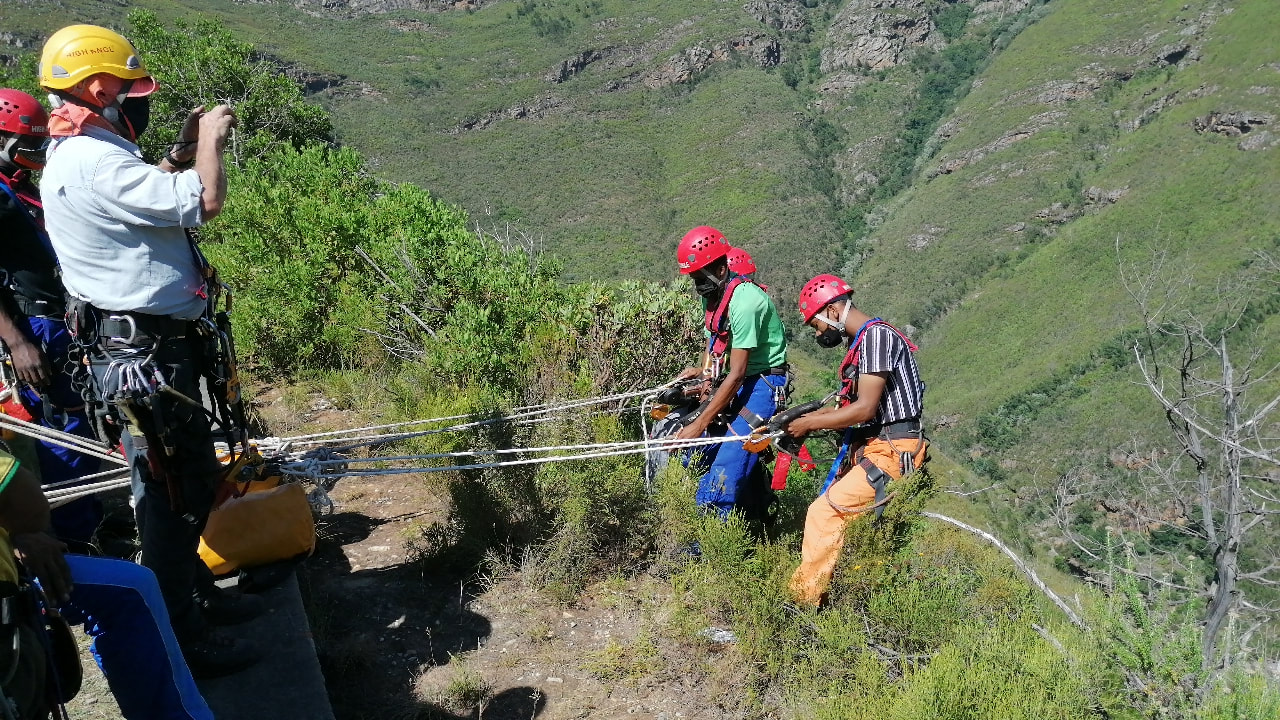|
The high altitude and access course took place in January, 2022. The training was led by Dion Tromp from Hi Angle Access and Rescue. Thank you to the South African National Biodiversity Institute for funding this training. Dion Tromp owns his own company and specialises in training courses for high altitude teams and focuses on high angle wilderness safety, and rescue training. In our case, allowing our teams to safely conduct alien clearing, while on ropes at height. Dion provides very important training to institutions, such as the SA Air Force and Working on Fire. We are grateful that he provided this specialised training to our alien clearing teams as he really is the best in the business. Dion is so calm and always has a smile on his face and it was lovely for the team to spend his Birthday with him. They all sang for him to celebrate with him. The purpose of the course. This course was designed for people who need to perform a task at height. In this case, our team needs to do alien clearing, in natural environments, such as on steeps slopes or vertical, mountain rock faces. When I walked into the shed with Linda, the conservancy's administrator, and saw our guys hanging on the ropes, we got goose bumps. We were impressed with this specialized training and how well Dion works with the trainees. The high angle training consisted of introduction to the course and theory as well as practical. The trainees learned how to inspect their equipment and perform the job as safely as possible. The participants also learned to rig simple anchors, ascent and descend. They mastered edge transition without high directional help, rope to rope transfers, maneuver through a re-anchor and maneuver through a deviation. The practical was done in our office shed and the rest in the Tradouw Pass. While doing the practical assessment in the Tradouw Pass, the ropes were tied to Dion’s car. The car was used as an anchor, and the trainees were able to do their exercise on the ropes. The training introduced a variety of rope access techniques, chosen specifically to improve the rescuer's ability to move through a static rope system. The trainees work at height, navigating rope obstacles and inspecting their equipment. We could see how interesting the training was, even our project manager, Ricardo, and quality control officer, Twakkie, tuned in to observe and familiarize themselves with the high-altitude training. When asked, the participants stated that they enjoyed the training, that it was challenging, and that they looked forward to each day. The training overall went well, so much so that we now have a very competent high-altitude team who are taking on the challenges of this important clearing work. Getting to work... We spoke with the Contractor (Marthinus Pick) who worked with the high-altitude team after the training. Marthinus Pick posed some questions to the team, such as the difficulties and high points of the high-altitude clearing. So, we turned it into a type of SWOT analysis (Strengths, Weakness, Opportunities, and threats). High- points (Strengths) They placed a high value on a sense of belonging to a group. When they work with the equipment and employ the proper methods, they feel good about it. They value the experience and the sense of accomplishment that comes with a successful day's work. They are also grateful because they are experiencing something that they had never considered doing before. Because the team had just returned from training and everything was still fresh, it was simple to apply the knowledge to the task. Challenges (Weakness) The terrain was challenging for them to navigate. It was also challenging to finish the task with enthusiasm and optimism. They expressed some difficulties adjusting from the clean, man made shed-structure that they had in the training to the realities of open rock faces where everything is a little more difficult to predict.The team did their best to apply the knowledge that they had gained from the training and the tasks that were assigned to them. Responsibilities (Opportunities) The team understands that they are each responsible for their own safety, as well as the safety of their team mates. They stated that they must ensure that their equipment is operational and that everything is in working order, and that it must be managed and monitored. Communication is also an important factor, and the team is aware that they must be able to communicate with one another on a regular basis to ensure that everything is still in order. Obtaining all of these skills presents great opportunities for each member to grow and perhaps move on to even greater things in life. This training has then opened them up to many new opportunities. What they believe can be improved (Threats) There are ways to improve by providing additional equipment for each member of the team so that more individuals can be on ropes at all times. It was noted that more attention must be paid to securing the anker because it causes the work to slow down if it is not in the proper place. As a team,there is a need to always plan carefully and follow through on what is agreed in the planning. Regardless of the obstacles, we are proud of the high altitude team's work thus far and look forward to seeing what they will achieve in the near future.
0 Comments
Your comment will be posted after it is approved.
Leave a Reply. |
AuthorGVB Conservancy Staff Archives
May 2024
Categories |






 RSS Feed
RSS Feed






